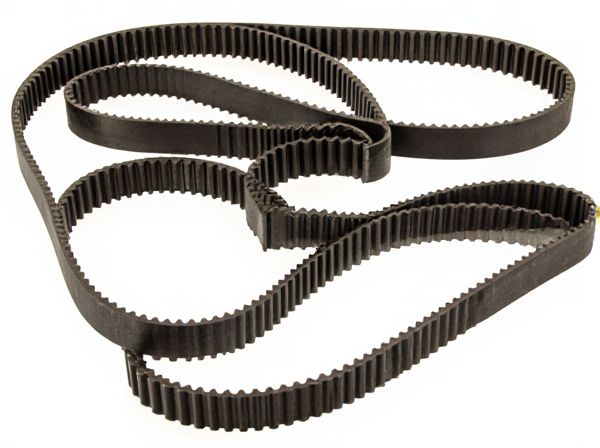
Photo illustration: Toothed Belt vs Cogged Belt
A toothed belt features evenly spaced teeth that fit precisely into matching grooves on pulleys, ensuring efficient power transmission without slippage. Cogged belts have notches or cogs on the underside, which provide flexibility and improved heat dissipation while maintaining grip on the pulley. Choosing between the two depends on your specific application requirements for torque, flexibility, and durability.
Table of Comparison
| Feature | Toothed Belt | Cogged Belt |
|---|---|---|
| Design | Continuous teeth for precise timing | Grooved cogs with flexible edges |
| Flexibility | Low flexibility, rigid structure | Higher flexibility, better bending |
| Efficiency | High power transmission efficiency | Moderate efficiency with reduced noise |
| Durability | Long lifespan, resistant to wear | Good durability, slight wear increase |
| Use Case | Precise engine timing, critical applications | General power transmission, flexible use |
Introduction to Toothed Belts and Cogged Belts
Toothed belts, also known as timing belts, feature molded teeth that mesh precisely with corresponding pulley grooves, ensuring synchronous power transmission without slippage. Cogged belts, a variation of V-belts, incorporate notches or cogs on the inner side to enhance flexibility and heat dissipation while maintaining high torque transfer efficiency. Both types are essential in mechanical systems demanding precise motion control and durability under varying load conditions.
Understanding the Design Differences
Toothed belts feature trapezoidal or rounded teeth that engage with matching pulleys, providing precise timing and reducing slippage in applications like timing belts in engines. Cogged belts have a series of V-shaped notches on their underside, enhancing flexibility and heat dissipation, making them ideal for high-torque or curved pulley systems. The design difference affects durability, efficiency, and noise levels, with toothed belts offering superior synchronicity and cogged belts offering better bend radius and cooling performance.
Material Composition and Durability
Toothed belts, commonly made from reinforced rubber or polyurethane with fiberglass or Kevlar cords, offer superior tensile strength and resistance to stretching, enhancing durability in high-load applications. Cogged belts, constructed from rubber compounds with embedded tensile fibers and distinct tooth profiles, provide improved flexibility and heat dissipation but may wear faster under heavy stress compared to toothed belts. Material composition directly impacts longevity, with toothed belts excelling in rigidity and wear resistance, while cogged belts balance durability with quieter operation and flexibility.
Efficiency and Power Transmission
Toothed belts offer higher efficiency in power transmission due to their positive engagement with pulleys, minimizing slippage and maintaining consistent speed ratios. Cogged belts, featuring notched designs, provide greater flexibility and heat dissipation, which improves efficiency under varying loads but may experience slight power loss compared to toothed belts. Choosing between the two depends on the application's demand for precise timing and torque versus adaptability and noise reduction.
Load Capacity and Performance
Toothed belts offer higher load capacity due to their positive engagement with pulley teeth, minimizing slippage and enhancing power transmission efficiency in high-torque applications. Cogged belts provide improved flexibility and reduced bending stress, which enhances performance in systems requiring moderate load capacity and quieter operation. Both belt types optimize drive performance, but toothed belts excel in applications demanding superior load handling and precision.
Installation and Maintenance Requirements
Toothed belts require precise alignment and tension during installation to prevent slippage and ensure efficient power transmission. Cogged belts offer easier installation due to their flexibility and reduced need for tension adjustment, which can minimize maintenance frequency. Regular inspection of both belt types is essential to monitor wear, with toothed belts often needing more frequent checks because of their rigid tooth profiles.
Noise Levels and Operating Smoothness
Toothed belts produce minimal noise due to their precise tooth engagement, ensuring smooth power transmission and reducing vibration. Cogged belts can generate slightly higher noise levels as their design accommodates flexibility over rigid tooth interaction, which may cause more vibration during operation. Both belt types offer smooth performance, but toothed belts excel in quieter, more consistent motion, ideal for noise-sensitive environments.
Cost Comparison and Lifespan
Toothed belts generally cost more upfront due to their precision manufacturing but offer a longer lifespan, often exceeding 100,000 miles in automotive applications. Cogged belts are less expensive initially and provide better flexibility and heat dissipation, resulting in a moderate lifespan typically ranging from 50,000 to 70,000 miles. Evaluating cost-performance balance involves considering long-term maintenance savings with toothed belts against the lower replacement frequency and initial investment of cogged belts.
Typical Applications in Industry and Automotive
Toothed belts are commonly used in automotive timing systems where precise synchronization between the crankshaft and camshaft is critical, ensuring optimal engine performance. In industrial settings, cogged belts provide superior flexibility and grip for power transmission in conveyor systems and packaging machinery, allowing efficient energy transfer with minimal slippage. Both belt types offer distinct advantages based on load requirements and operational environments, with toothed belts favoring precision timing tasks and cogged belts excelling in general power transmission.
Choosing the Right Belt for Your Needs
Choosing the right belt for your needs depends on factors such as load capacity, noise level, and flexibility. Toothed belts provide high torque transmission and precise timing, making them ideal for heavy-duty machinery and automotive timing applications. Cogged belts offer improved flexibility and heat dissipation, making them suitable for smaller pulleys and applications with tight bend radii where quieter operation is desired.
 caratoz.com
caratoz.com